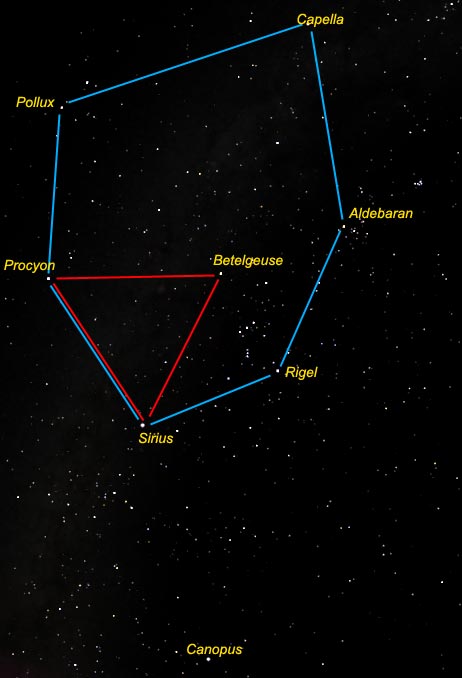
The Winter Hexagon or Winter Circle/Oval is an asterism appearing to be in the form of a hexagon with vertices at Rigel, Aldebaran, Capella, Pollux, Procyon, and Sirius. It is mostly upon the Northern Hemisphere’s celestial sphere. The stars in the hexagon are parts of six constellations. Counter-clockwise around the hexagon, starting with Rigel, these are Orion, Taurus, Auriga, Gemini, Canis Minor, and Canis Major.
On most locations on Earth (except from the South Island of New Zealand and the south of Chile and Argentina and further south), this asterism is prominently in the sky from approximately December to March. In the tropics and southern hemisphere, this (then called “summer hexagon”) can be extended with the bright star Canopus in the south.
Smaller and more regularly shaped is the Winter Triangle (also known as the Great Southern Triangle), an approximately equilateral triangle that shares two vertices (Sirius and Procyon) with the larger asterism. The third vertex is Betelgeuse, which lies near the center of the hexagon. It includes three of the most brilliant stars in the sky, and it is called an “asterism” because it is not a single constellation, but a combination of stars from three different constellations.
These three stars are three of the ten brightest objects, as viewed from Earth, outside the Solar System. Betelgeuse is also particularly easy to locate, being a shoulder of Orion, which assists stargazers in finding the triangle. Once the triangle is located, the larger hexagon may then be found. Several of the stars in the hexagon may also be found independently of one another by following various lines traced through various stars in Orion.
The first and brightest star is Sirius, the brightest star in the night sky. Sirius is close to the Solar Systems (8 light years) and has a slight blue coloration. Sirius is in the constellation Canis Major, the big dog that accompanies Orion. To the upper right is Betelgeuse, a red supergiant star in Orion that is a distinctive orange color. Betelgeuse is so big that if it was our Sun, it would envelop Mercury, Venus, Earth and Mars! And the third star of the triangle is Procyon, in the constellation Canis Minor, the small dog that accompanies Orion. Procyon is actually a double-star system with a faint partner star.
Procyon (α CMi, α Canis Minoris, Alpha Canis Minoris) is the brightest star in the constellation Canis Minor. Its name is Latin for “lesser dog”, in contrast to Canis Major, the “greater dog”; both figures are commonly represented as following the constellation of Orion the hunter.
Its name comes from the ancient Greek Prokyon, meaning “before the dog”, since it precedes the “Dog Star” Sirius as it travels across the sky due to Earth’s rotation. (Although Procyon has a greater right ascension, it also has a more northerly declination, which means it will rise above the horizon earlier than Sirius from most northerly latitudes.) In Greek mythology, Procyon is associated with Maera, a hound belonging to Erigone, daughter of Icarius of Athens.
These two dog stars are referred to in the most ancient literature and were venerated by the Babylonians and the Egyptians. In Babylonian mythology, Procyon was known as Nangar the Carpenter, an aspect of Marduk, involved in constructing and organising the celestial sky.
Sirius is the brightest star (in fact, a star system) in the Earth’s night sky. The name “Sirius” is derived from the Ancient Greek Seirios, meaning “glowing” or “scorcher”. Sirius is also known colloquially as the “Dog Star”, reflecting its prominence in its constellation, Canis Major (Greater Dog).
The heliacal rising of Sirius marked the flooding of the Nile in Ancient Egypt and the “dog days” of summer for the ancient Greeks, while to the Polynesians in the Southern Hemisphere the star marked winter and was an important reference for their navigation around the Pacific Ocean.
Betelgeuse, also known by its Bayer designation Alpha Orionis (shortened to α Orionis or α Ori), is the ninth-brightest star in the night sky and second-brightest in the constellation of Orion. The star’s name is derived from the Arabic Ibt al-Jauzā’, meaning “the hand of Orion”. The Arabic letter for Y (which has two dots) was misread as B (with one dot) by medieval translators, creating the initial B in Betelgeuse. Betelgeuse is one of three stars that make up the Winter Triangle, and it marks the center of the Winter Hexagon.
Filed under: Uncategorized